Last month, while proudly wearing press credentials that gave me insider access to the Royal Horticultural Society’s legendary Chelsea Flower Show, I spent a day touring the 15 major show gardens, nine smaller fresh gardens and the Great Pavilion (filled with nursery displays and horticultural collections) to study and photograph the best of the plant world’s best.
For just five days each May, the media spotlight turns to this corner of London, where leading landscape design and horticultural talents showcase their creativity. Unlike major U.S. flower shows in Philadelphia and Seattle, the spring RHS flower show takes place outdoors, on the grounds of the Royal Hospital Chelsea. That means the sky is the ceiling, infusing these designs with the variable of nature, including rain (umbrellas are a must).
There was so much to see at this grande dame of all flower shows that I’ve organized my favorites ideas into a series of Houzz stories. My first installment covered Chelsea 2015 winning show gardens. This story looks at design ideas, plants and plant combinations that caught my eye.

Debra Prinzing
My press credentials gave me full access to the most beautiful gardens and planting designs.
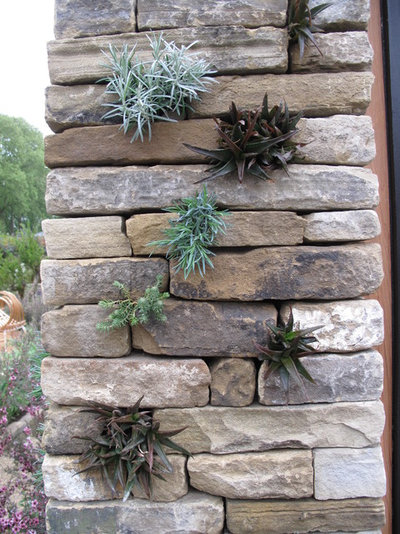
Debra Prinzing
Garden Design
Drought-tolerant plantings. In the Royal Bank of Canada Garden, designed to showcase sustainable ideas for how water management in an urban garden can be visually stunning, designer Matthew Wilson drew much inspiration from the Mediterranean landscape. Here, in nooks of a vertical stone wall, he has tucked succulents and arid plants where they are designed to take root, lending a modern twist to rustic stone.
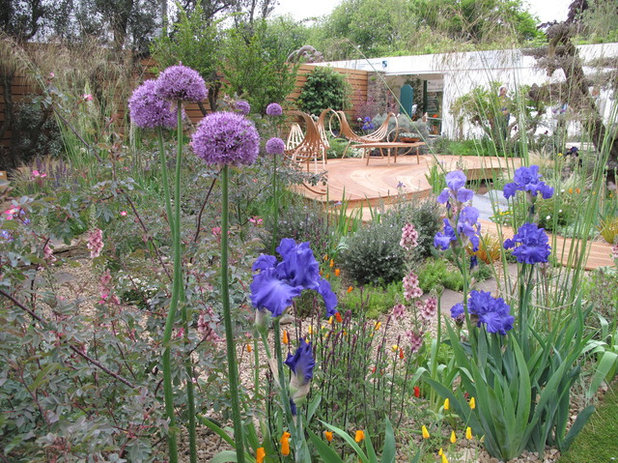
Debra Prinzing
In another view of Wilson’s design for the Royal Bank of Canada Garden, the drought-tolerant plantings are anything but dull. There’s an alluring see-through quality to the ornamental alliums and bearded irises, allowing the viewer to peer into the garden from a distance.
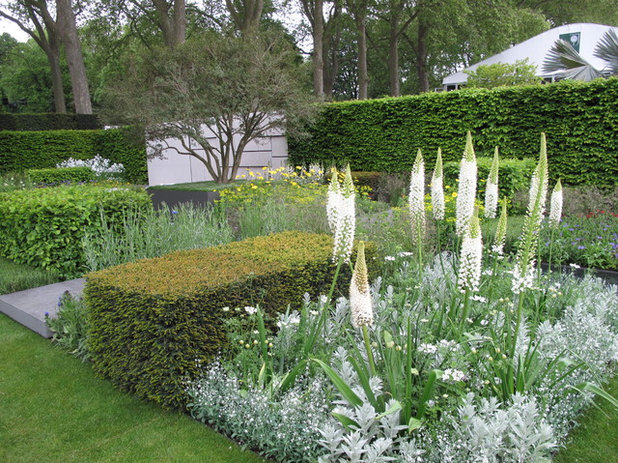
Debra Prinzing
Color-blocking. For The Telegraph Garden, Marcus Barnett designed a garden inspired by the De Stijl movement, a group of Dutch architects and artists known for simplifying visual composition to the vertical and horizontal.
Barnett’s landscape could easily be called a color-block style, with rectilinear bands or square planting sections. A white-planted block of perennials is simply dazzling, especially with the mix of high and low flowers and foliage.
Especially dramatic are the white foxtail lilies (
Eremurus sp), which emerge tall above a playful white tapestry of
Viola cornuta ‘Alba Group’, ornamental onion (
Allium nigrum),
Centranthus ruber ‘Albus’,
Artemisia ludoviciana ‘Valerie Finnis’ and
Hesperis matronalis var
. albiflora. Take that recipe to the garden center and you may be able to replicate a slice of Chelsea in your own backyard.
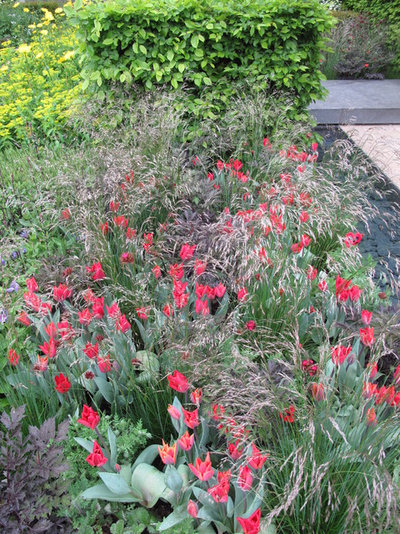
Debra Prinzing
The red-themed blocks caught my eye, thanks to the beautiful interplanting of
Tulipa ‘Red Hat’ with wavy hair grass (
Deschampsia flexuosa) and what looks to be the burgundy foliage of an astilbe.
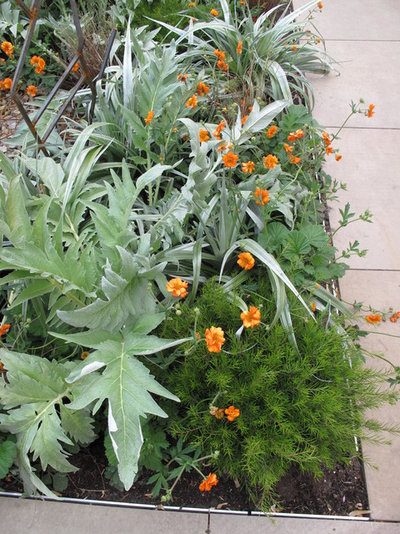
Debra Prinzing
Softening the base of a sculptural piece called Xylem is a fantastic silver and orange planting scheme that I found dramatic in its simplicity.
Silvery Astelia and artichoke foliage is accented by an orange-flowering Geum and a bronzy carex. This can be easily replicated in a container garden or a small planting bed.
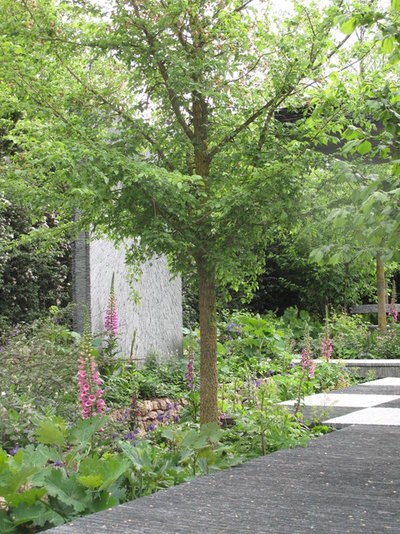
Debra Prinzing
Vertical lines. In The Brewin Dolphin Garden, designed by Darren Hawkes, stately English elms (
Ulmus minor) stand tall, holding their own against the massive slate walls and walks. At the base of the trees, perennials echo the vertical thrust of the trunks, including foxgloves, columbine, plume poppy, viburnum, larkspur and angelica.
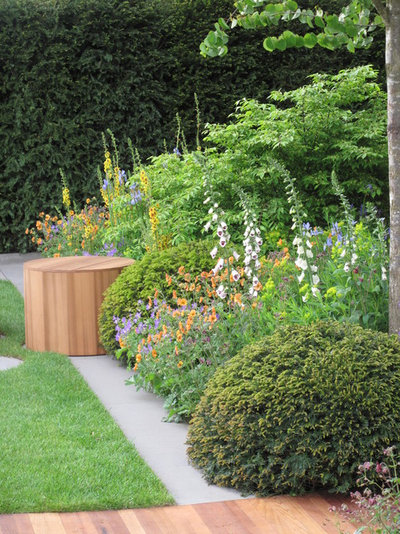
Debra Prinzing
Foxglove is just one of the spiked or spire-formed perennials that can make a spring garden dynamic. This was especially evident at Chelsea, where small display gardens had to make a big impact to wow judges and the public alike. In The Homebase Garden - Urban Retreat, designer Adam Frost gave vertical plants a starring role. In addition to foxgloves, he relied on bearded irises, euphorbias and hardy geraniums to create a pleasing tapestry that also attracts beneficial insects.
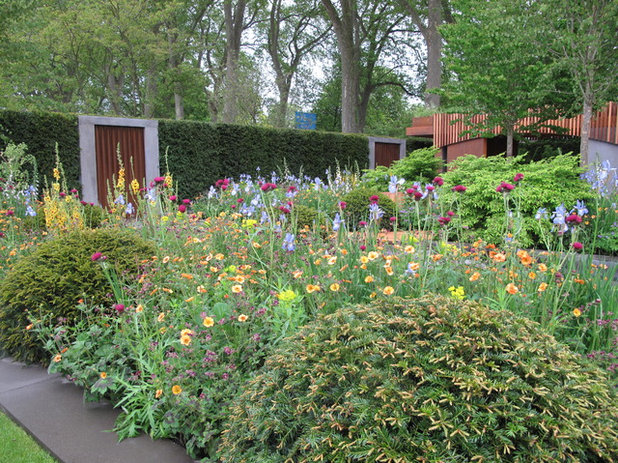
Debra Prinzing
Mounds. Here’s another view of Frost’s inspired border for The Homebase Garden, in which the soft perennial sections are anchored with domes of clipped yews (
Taxus baccata). The evergreen mounds provide a visual calmness, and the dense forms create inviting nesting spaces for insects and birds.
See more photos of this garden
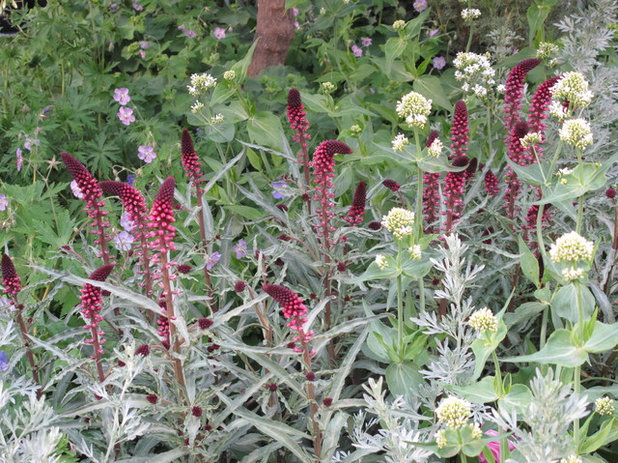
Debra Prinzing
Plants
A noninvasive loosestrife. One of my favorite discoveries appeared and reappeared in numerous display gardens: the burgundy gooseneck loosestrife, a noninvasive cultivar called
Lysimachia atropurpurea ‘Beaujolais’. In The M&G Garden, designed by Jo Thompson, the graceful wine-hued spikes grow companionably with
Centranthus album, a white-flowering perennial, and
Artemisia absinthium ‘Lambrook Silver’ with pewter foliage.

Debra Prinzing
Geum. Whether we credit the popularity of the perennial called Geum to its perfect timing of blooming during Chelsea, or to its gorgeous petal color, or to its whimsical form, it all adds up to a stellar choice for a mixed border, cutting garden or container.
Geum rivale ‘Flames of Passion’ (USDA zones 4 to 8) is aptly named. According to Bluestone Perennials, it is deer and rabbit resistant, attracts butterflies, is long-blooming and is a perfect compact, low-growing plant.
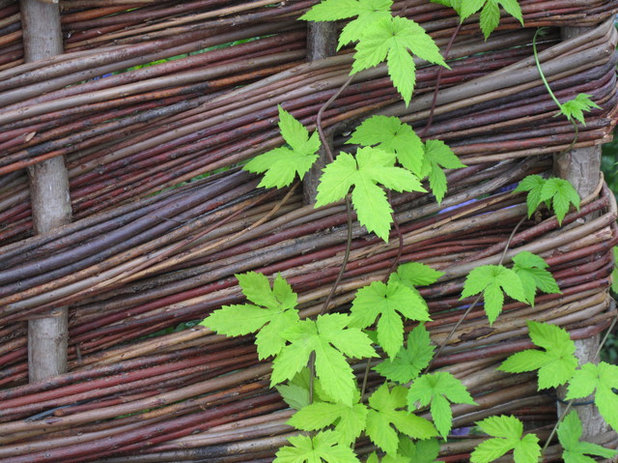
Debra Prinzing
Golden hop vine. Golden hop vine (
Humulus lupulus ‘Aureus’) is a lemon-lime stunner, a favorite quick-growing, gold-leaved selection of common hops. And it looks fresh and new against classic English wattle fencing made from thin woven branches. Get this look in your own garden by training hops against a willow trellis or fence.
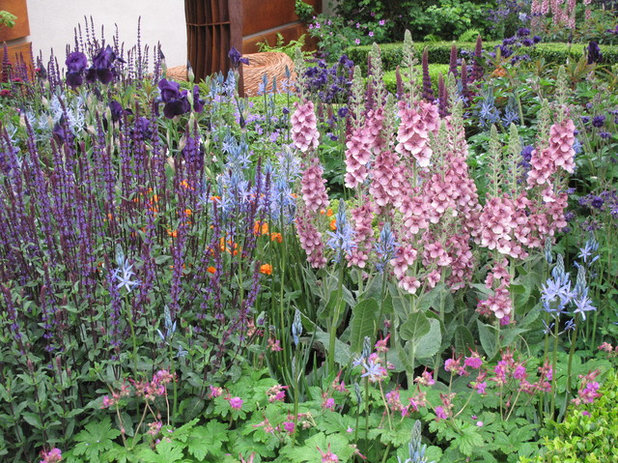
Debra Prinzing
Plant CombinationsColorful perennials. A fabulous perennial combo anchors a featured planting bed in Chris Beardshaw’s design, At the Heart of the Community, for The Morgan Stanley Healthy Cities Garden. Purple
Salvia nemorosa ‘Caradonna’, peach
Verbascum ‘Merlin’, several forms of blue Camassia, and a pink-flowering geranium have been knitted together in an eye-pleasing way.
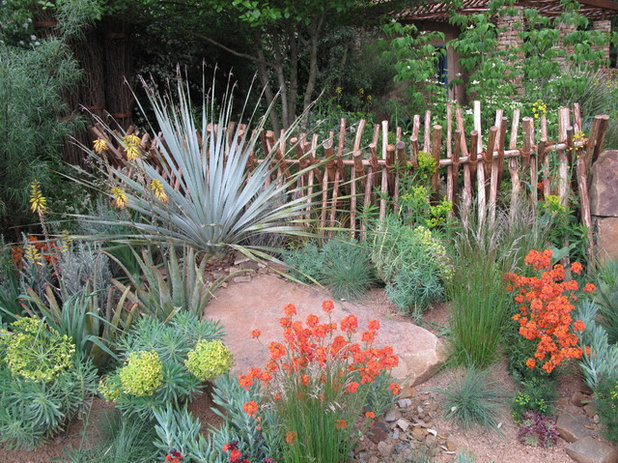
Debra Prinzing
Earthy mix. Prince Harry of Britain and Prince Seeiso of Lesotho founded the organization Sentebale to help vulnerable children in the southern African country of Lesotho. To commemorate the charity’s Mamohato Children’s Centre, Matt Heightley designed Sentebale - Hope in Vulnerability, which transports showgoers to the Lesotho landscape. The vibrant floral palette plays off the browns and rusts of the hardscape. And that makes it impossible to ignore the energizing combination of bright orange wallflower (
Erysimum ‘Apricot Twist’ and
E. ‘Winter Rouge’) and yellow-flowering aloes against blue-green euphorbia and
Senecio serpens.More:See Winning Gardens From the 2015 Chelsea Flower Show
At the Chelsea Flower Show, a Jewel-Colored, Wildlife-Friendly Garden





